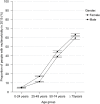Trends in multimorbidity and polypharmacy in the Flemish-Belgian population between 2000 and 2015
- PMID: 30753214
- PMCID: PMC6372187
- DOI: 10.1371/journal.pone.0212046
Trends in multimorbidity and polypharmacy in the Flemish-Belgian population between 2000 and 2015
Abstract
Objectives: The aim of this paper was to describe the time trends in the prevalence of multimorbidity and polypharmacy in Flanders (Belgium) between 2000 and 2015, while controlling for age and sex.
Methods: Data were available from Intego, a Flemish-Belgian general practice-based morbidity registration network. The practice population between 2000 and 2015 was used as the denominator, representing a mean of 159,946 people per year. Age and gender-standardised prevalence rates were used for the trends of multimorbidity and polypharmacy in the total population and for subgroups. Joinpoint regression analyses were used to analyse the time trends and breaks in trends, for the entire population as well as for specific age and sex groups.
Results: Overall, in 2015, 22.7% of the population had multimorbidity, while the overall prevalence of polypharmacy was 20%. Throughout the study period the standardised prevalence rate of multimorbidity rose for both sexes and in all age groups. The largest relative increase in multimorbidity was observed in the younger age groups (up to the age of 50 years). The prevalence of polypharmacy showed a significant increase between 2000 and 2015 for all age groups except the youngest (0-25 years).
Conclusion: For all adult age groups multimorbidity and polypharmacy are frequent, dynamic over time and increasing. This asks for both epidemiological and interventional studies to improve the management of the resulting complex care.
Conflict of interest statement
The authors have declared that no competing interests exist.
Figures



References
-
- Van den Akker M, Buntinx F, Knottnerus JA. Comorbidity or multimorbidity: what’s in a name? A review of literature. Eur J Gen Pract. 1996;2:65–70.
MeSH terms
LinkOut - more resources
Full Text Sources

